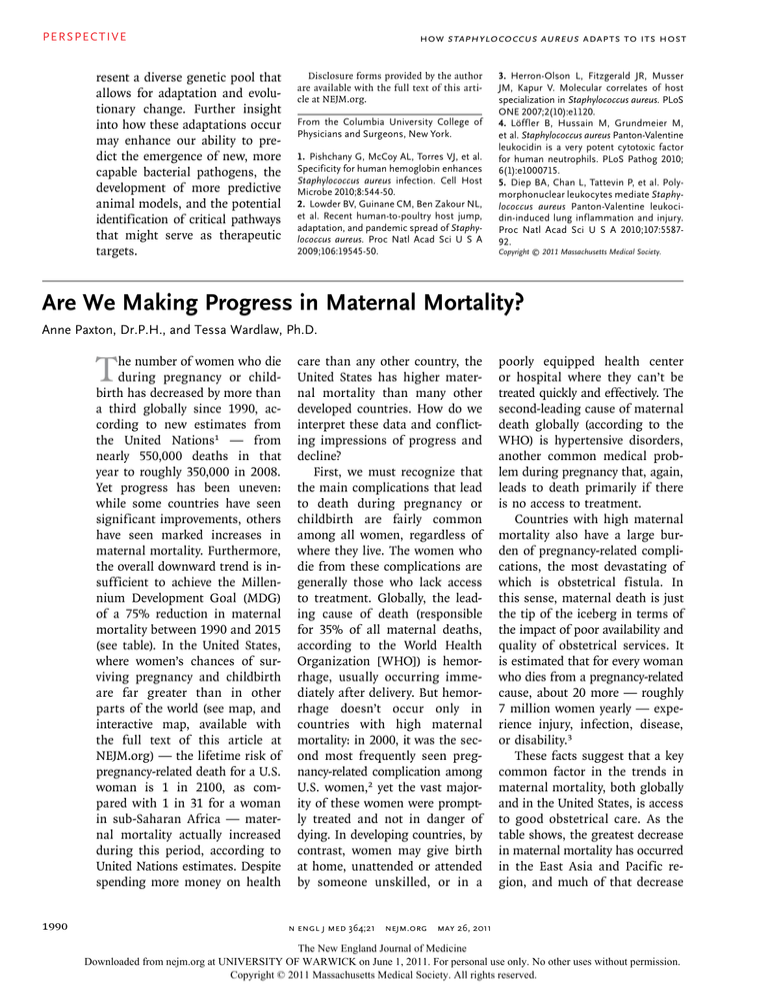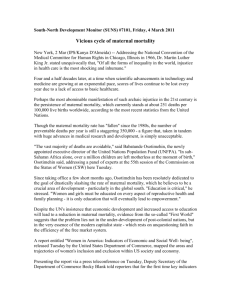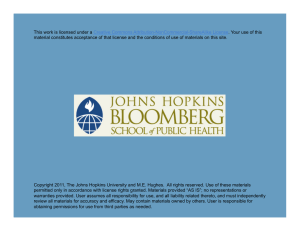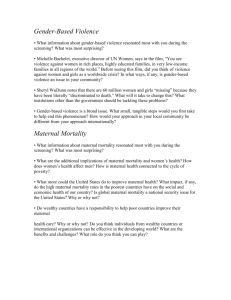
PERSPE C T I V E
resent a diverse genetic pool that
allows for adaptation and evolutionary change. Further insight
into how these adaptations occur
may enhance our ability to predict the emergence of new, more
capable bacterial pathogens, the
development of more predictive
animal models, and the potential
identification of critical pathways
that might serve as therapeutic
targets.
How staphylococcus aureus Adapts to Its Host
Disclosure forms provided by the author
are available with the full text of this article at NEJM.org.
From the Columbia University College of
Physicians and Surgeons, New York.
1. Pishchany G, McCoy AL, Torres VJ, et al.
Specificity for human hemoglobin enhances
Staphylococcus aureus infection. Cell Host
Microbe 2010;8:544-50.
2. Lowder BV, Guinane CM, Ben Zakour NL,
et al. Recent human-to-poultry host jump,
adaptation, and pandemic spread of Staphylococcus aureus. Proc Natl Acad Sci U S A
2009;106:19545-50.
3. Herron-Olson L, Fitzgerald JR, Musser
JM, Kapur V. Molecular correlates of host
specialization in Staphylococcus aureus. PLoS
ONE 2007;2(10):e1120.
4. Löffler B, Hussain M, Grundmeier M,
et al. Staphylococcus aureus Panton-Valentine
leukocidin is a very potent cytotoxic factor
for human neutrophils. PLoS Pathog 2010;
6(1):e1000715.
5. Diep BA, Chan L, Tattevin P, et al. Polymorphonuclear leukocytes mediate Staphylococcus aureus Panton-Valentine leukocidin-induced lung inflammation and injury.
Proc Natl Acad Sci U S A 2010;107:558792.
Copyright © 2011 Massachusetts Medical Society.
Are We Making Progress in Maternal Mortality?
Anne Paxton, Dr.P.H., and Tessa Wardlaw, Ph.D.
T
he number of women who die
during pregnancy or childbirth has decreased by more than
a third globally since 1990, according to new estimates from
the United Nations1 — from
nearly 550,000 deaths in that
year to roughly 350,000 in 2008.
Yet progress has been uneven:
while some countries have seen
significant improvements, others
have seen marked increases in
maternal mortality. Furthermore,
the overall downward trend is insufficient to achieve the Millennium Development Goal (MDG)
of a 75% reduction in maternal
mortality between 1990 and 2015
(see table). In the United States,
where women’s chances of surviving pregnancy and childbirth
are far greater than in other
parts of the world (see map, and
interactive map, available with
the full text of this article at
NEJM.org) — the lifetime risk of
pregnancy-related death for a U.S.
woman is 1 in 2100, as compared with 1 in 31 for a woman
in sub-Saharan Africa — maternal mortality actually increased
during this period, according to
United Nations estimates. Despite
spending more money on health
1990
care than any other country, the
United States has higher maternal mortality than many other
developed countries. How do we
interpret these data and conflicting impressions of progress and
decline?
First, we must recognize that
the main complications that lead
to death during pregnancy or
childbirth are fairly common
among all women, regardless of
where they live. The women who
die from these complications are
generally those who lack access
to treatment. Globally, the leading cause of death (responsible
for 35% of all maternal deaths,
according to the World Health
Organization [WHO]) is hemorrhage, usually occurring immediately after delivery. But hemorrhage doesn’t occur only in
countries with high maternal
mortality: in 2000, it was the second most frequently seen pregnancy-related complication among
U.S. women,2 yet the vast majority of these women were promptly treated and not in danger of
dying. In developing countries, by
contrast, women may give birth
at home, unattended or attended
by someone unskilled, or in a
poorly equipped health center
or hospital where they can’t be
treated quickly and effectively. The
second-leading cause of maternal
death globally (according to the
WHO) is hypertensive disorders,
another common medical problem during pregnancy that, again,
leads to death primarily if there
is no access to treatment.
Countries with high maternal
mortality also have a large burden of pregnancy-related complications, the most devastating of
which is obstetrical fistula. In
this sense, maternal death is just
the tip of the iceberg in terms of
the impact of poor availability and
quality of obstetrical services. It
is estimated that for every woman
who dies from a pregnancy-related
cause, about 20 more — roughly
7 million women yearly — experience injury, infection, disease,
or disability.3
These facts suggest that a key
common factor in the trends in
maternal mortality, both globally
and in the United States, is access
to good obstetrical care. As the
table shows, the greatest decrease
in maternal mortality has occurred
in the East Asia and Pacific region, and much of that decrease
n engl j med 364;21 nejm.org may 26, 2011
The New England Journal of Medicine
Downloaded from nejm.org at UNIVERSITY OF WARWICK on June 1, 2011. For personal use only. No other uses without permission.
Copyright © 2011 Massachusetts Medical Society. All rights reserved.
PERSPECTIVE
Are We Making Progress in Maternal Mortality?
Trends in Maternal Mortality Ratios, 1990–2008.*
UNICEF Region
Estimated Maternal Mortality Ratio
(No. of Maternal Deaths per 100,000 Live Births)
1990
1995
2000
2005
Percent Change
between
1990 and 2008
Annual
Percent Change
between
1990 and 2008
2008
Sub-Saharan Africa
870
850
790
710
640
−26
−1.7
Eastern and Southern Africa
750
760
720
630
550
−26
−1.7
West and Central Africa
980
940
870
780
720
−27
−1.7
Middle East and North Africa
270
230
200
180
170
−37
−2.6
South Asia
610
510
430
330
290
−53
−4.2
East Asia and Pacific
200
160
130
100
88
−56
−4.5
Latin America and the Caribbean
140
130
110
91
85
−41
−2.9
Central Eastern Europe/Commonwealth
of Independent States
69
60
48
36
34
−52
−4.0
Industrialized Countries
12
10
11
14
14
16
0.8
Developing countries
440
410
370
320
290
−34
−2.3
Least developed countries
900
840
750
650
590
−35
−2.4
World
400
370
340
290
260
−34
−2.3
*Data are United Nations interagency estimates. Maternal mortality ratios have been rounded as follows: less than 100, no rounding; 100 to
999, rounded to nearest 10; and greater than 1000, rounded to nearest 100. Negative values for percent changes indicate decreases in maternal mortality; positive values indicate increases. Since the uncertainty intervals are wide for some countries, the data should be interpreted cautiously.
is due to improvements in care in
China, the region’s most highly
populated country. China reports
dramatic decreases in maternal
mortality, from 110 per 100,000
live births in 1990 to 38 per
100,000 live births in 2008, a
65% decrease. During this period,
China saw an increase in the proportion of women giving birth assisted by a skilled provider, as well
as an increase in the proportion
of births taking place in hospitals or other health care institutions from 51% in 1990 to 92%
in 2007, according to UNICEF.
Bangladesh, another Asian country with a huge population, also
made significant progress in reducing maternal mortality, as have
many other countries in South
and Southeast Asia — a notable
exception being war-torn Afghanistan, which saw almost no decrease in its remarkably high ma-
ternal mortality ratio. Many other
parts of the world — Latin
America, Central Eastern Europe,
North Africa, and the Middle East
— have seen gradual, steady decreases in deaths during pregnancy, childbirth, and the postnatal
period, reflecting improvements
in the quality of and access to
obstetrical care as well as decreases in fertility rates. In fact,
90 countries had decreases in maternal mortality of 40% or more.
Sub-Saharan Africa has the
greatest burden of maternal mortality. Yet there, too, the story is
not uniform. Most countries in
the region have seen small but
promising decreases in maternal
mortality, with notable and stark
exceptions. The countries with
substantial increases tend to fall
into two categories: countries
whose health systems have been
decimated by war or internal con-
flict, such as Congo and Somalia
(other conflict-ridden countries
with extremely high maternal
mortality, such as Chad, Liberia,
and Guinea Bissau, showed only
very small improvements), and
countries with extremely high
rates of infection with human
immunodeficiency virus (HIV),
such as South Africa, Botswana,
Swaziland, Lesotho, Kenya, Zimbabwe (which has also experienced internal strife), and Zambia. The HIV epidemic affects
maternal mortality both directly
— since HIV-positive women are
more likely than HIV-negative
women to die from opportunistic
infections, postpartum sepsis, and
hemorrhage4 — and indirectly,
through stresses on the health
system and loss of physicians and
nurses to death and migration.
Care for HIV-positive pregnant
women has focused primarily on
n engl j med 364;21 nejm.org may 26, 2011
The New England Journal of Medicine
Downloaded from nejm.org at UNIVERSITY OF WARWICK on June 1, 2011. For personal use only. No other uses without permission.
Copyright © 2011 Massachusetts Medical Society. All rights reserved.
1991
PERSPE C T I V E
Are We Making Progress in Maternal Mortality?
Maternal Mortality Ratio, 2008
(deaths per 100,000 live births)
<20
20 – 99
100 – 299
300 –549
550 – 999
≥1000
Data not shown
COLOR FIGURE
Maternal Mortality Ratios, 2008.
Data are the numbers of maternal deaths per 100,000 live births. Data are from the WHO, UNICEF, the United
Nations Population
Fund, and
Rev1
03/08/11
the World Bank. The boundaries used do not imply official endorsement or acceptance by the United Nations.
interactive
Author An Dr.
Paxtonmap showing
changes in maternal mortality ratios over time is available with the full text of this article at NEJM.org. Fig #
1
preventing transmission of the virus to the
child; the finding that
maternal mortality is
high among HIV-positive women suggests that more
attention should be paid to treating the women themselves.
Within countries, higher rates
of death are found among more
economically disadvantaged women. In the United States, for example, black women are three
times as likely as white women to
die during pregnancy or childbirth.5 Although data on maternal mortality broken down according to economic status are
not generally available, data analyzed by UNICEF show that in
all regions of the world, women
from the wealthiest 20% of households are more likely than those
An interactive
map showing
changes in maternal
mortality ratios is
available at NEJM.org
1992
from the poorest 20% to deliver
their babies with the assistance of
skilled health personnel — a
proxy for pregnant women’s access to care. In South Asia, the
wealthiest women are nearly five
times as likely as the poorest
women to give birth with a skilled
attendant present; poorer women
tend to deliver at home with the
help of a family member or poorly trained attendant. In China,
where detailed data are available,
the maternal mortality ratio in
rural areas in 2004 was approximately three times that in urban
areas. In sub-Saharan Africa,
poor women living in rural areas
are particularly vulnerable to dying during pregnancy or childbirth because they lack access to
obstetrical services — for example, surgery for cesarean delivery,
n engl j med 364;21
nejm.org
Title
an ME
essential
lifesaving interventionDEfor women
with prolonged,
Malina
obstructed
labor.
Daniel Muller
Artist
PLEASE
Where AUTHOR
does all
thisNOTE:
leave us?
Figure has been redrawn and type has been reset
Should we Please
celebrate
the global
check carefully
improvements
in maternal morIssue date 04/28/2011
tality or chide ourselves for not
being on target to meet the
MDGs for maternal health? The
overall picture is one of gradual
but steady reduction in maternal
deaths in most areas of the world
— a global public health improvement that calls for cautious
optimism. The attention that has
been paid to the plight of women
at risk of dying during pregnancy
or childbirth and increased investments in health care systems, especially in basic and comprehensive emergency obstetrical care,
have paid off. The dramatic improvements in China and gains
may 26, 2011
The New England Journal of Medicine
Downloaded from nejm.org at UNIVERSITY OF WARWICK on June 1, 2011. For personal use only. No other uses without permission.
Copyright © 2011 Massachusetts Medical Society. All rights reserved.
PERSPECTIVE
in other Asian countries, which
are associated with economic improvement, decreasing fertility
rates, and strengthening of health
systems, contrast with sharp increases in countries experiencing
the chaos and destruction of war
and HIV epidemics. The overall
rate of decline in global maternal
mortality, 2.3%, is lower than
the 5.5% MDG target but is
heartening nonetheless. We believe that continued focus on national and district-level planning
to make pregnancy and delivery
safer and to improve treatment
Are We Making Progress in Maternal Mortality?
of obstetrical complications, with
particular attention to disadvantaged women, including those
with HIV, will accelerate progress over the next decade.
The views expressed in this article are
those of the authors and do not necessarily
reflect those of UNICEF or the United Nations.
Disclosure forms provided by the authors
are available with the full text of this article at NEJM.org.
From the Departments of Epidemiology
and Population and Family Health, Mailman
School of Public Health, Columbia University (A.P.); and the Statistics and Monitoring Section, Division of Policy and Practice,
UNICEF (T.W.) — both in New York.
1. World Health Organization, UNICEF,
UNFPA, and The World Bank. Trends in
maternal mortality: 1990 to 2008. Geneva:
World Health Organization, 2010.
2. Lobis S, Fry D, Paxton A. Program note:
applying the UN process indicators for emergency obstetric care to the United States. Int
J Gynaecol Obstet 2005;88:203-7.
3. Nanda G, Switlick K, Lule E. Accelerating
progress towards achieving the MDG to improve maternal health: a collection of promising approaches. Washington, DC: World
Bank, April 2005:4.
4. Abdool-Karim Q, AbouZahr C, Dehne K,
et al. HIV and maternal mortality: turning
the tide. Lancet 2010;375:1948-9.
5. Kung HC, Hoyert DL, Xu J, Murphy SL.
Deaths: Final Data for 2005. Natl Vital Stat
Rep 2008;56:1-120.
Copyright © 2011 Massachusetts Medical Society.
n engl j med 364;21 nejm.org may 26, 2011
The New England Journal of Medicine
Downloaded from nejm.org at UNIVERSITY OF WARWICK on June 1, 2011. For personal use only. No other uses without permission.
Copyright © 2011 Massachusetts Medical Society. All rights reserved.
1993








